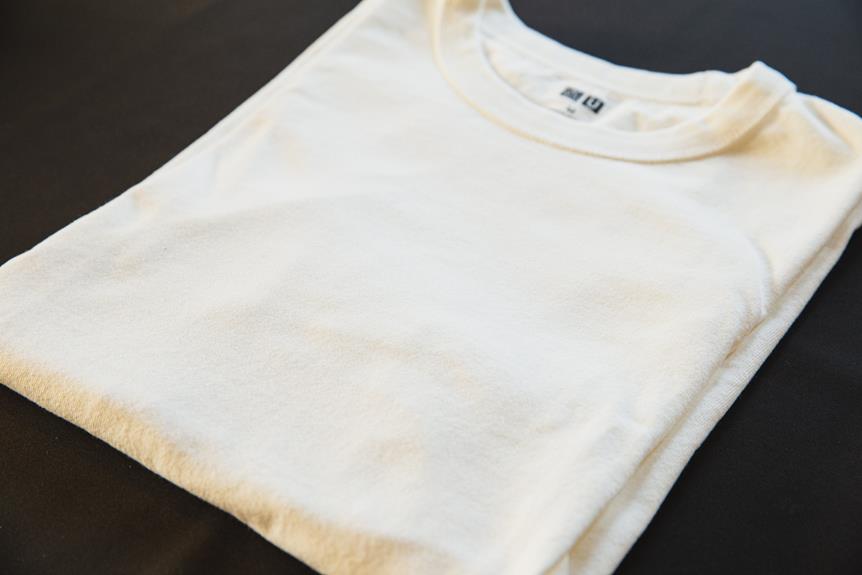Looking to keep your shirts bright without damaging the fabric? Did you know that 65% of people believe that bleaching shirts can ruin them? Fear not, as we've compiled 5 fabric-safe bleaching techniques that will leave your shirts looking fresh and vibrant.
With these methods, you can effectively remove stains and revitalize your shirts without worrying about weakening the fabric. From the oxygen bleach method to the hydrogen peroxide spray technique, each approach is carefully selected to ensure the safety of your shirt while delivering impressive results.
Whether you're dealing with tough stains or simply looking to brighten up your wardrobe, mastering these fabric-safe bleaching techniques will elevate your laundry game.
Key Takeaways
- Oxygen bleach is a safer alternative to chlorine bleach for removing stains and brightening colors without compromising fabric integrity.
- The lemon juice and sunlight technique can naturally bleach and freshen shirts by using a mixture of lemon juice and water, followed by exposure to direct sunlight.
- Vinegar is an environmentally friendly alternative to harsh chemical bleaches and can be used to balance the pH of fabric, remove stains and odors, and leave shirts feeling fresh and comfortable.
- Baking soda paste is a gentle and effective natural alternative for stain removal and shirt refreshing, as it brightens and whitens shirts without harsh chemicals, absorbs and neutralizes odors, and is safe for fabrics.
Oxygen Bleach Method
If you want to brighten your shirts without causing damage, you can use the oxygen bleach method. Oxygen bleach, also known as all-fabric bleach, is a safer alternative to chlorine bleach. It's effective in removing stains and brightening colors without compromising the fabric's integrity.
When using oxygen bleach, it's important to prioritize safety. Always follow the manufacturer's instructions and wear protective gloves to prevent any skin irritation. Additionally, ensure good ventilation in the area where you're working with oxygen bleach.
When it comes to color preservation techniques, oxygen bleach is a top choice. Unlike chlorine bleach, which can cause colors to fade or change, oxygen bleach is gentler on fabrics and helps maintain the vibrancy of your shirts. This makes it a preferred option for brightening whites and keeping colored shirts looking fresh. However, it's still essential to test a small, inconspicuous area of the shirt before proceeding with a full treatment to ensure that the color won't be affected.
Lemon Juice and Sunlight Technique
To naturally lighten and freshen your shirts, consider using the lemon juice and sunlight technique. This natural alternative to bleaching is gentle on fabrics, making it an excellent choice for fabric preservation.
Here's how to use this method effectively:
- Prepare the Solution: Mix equal parts of lemon juice and water in a spray bottle. Shake well to ensure thorough mixing.
- Apply to Stained Areas: Spray the lemon juice solution directly onto the stained areas of the shirt. Ensure that the fabric is damp but not saturated.
- Sun Exposure: Place the treated shirt in direct sunlight. The UV rays will interact with the lemon juice to naturally bleach and freshen the fabric.
- Rinse and Dry: After a few hours in the sun, rinse the shirt thoroughly and wash it as usual. Allow it to air dry.
Vinegar Soak and Wash
After using the lemon juice and sunlight technique to naturally lighten and freshen your shirts, another effective fabric-safe bleaching method is the vinegar soak and wash. Vinegar is a versatile natural fabric brightener that not only helps to whiten clothes but also softens the fabric and eliminates odors. The acidic nature of vinegar makes it an excellent option for maintaining fabric pH balance while effectively removing stains and odors.
| Benefits of Vinegar Soak and Wash | Description |
|---|---|
| Fabric pH balance | Vinegar helps to balance the pH of the fabric, keeping it in good condition. |
| Natural fabric brighteners | The natural acidity of vinegar acts as a fabric brightener, effectively removing stains and odors. |
| Softens fabric | Vinegar also works to soften the fabric, leaving your shirts feeling fresh and comfortable. |
| Environmentally friendly | Vinegar is an eco-friendly alternative to harsh chemical bleaches, making it a sustainable choice. |
| Versatile use | Apart from bleaching, vinegar can be used in various fabric care routines, making it a versatile household item. |
Baking Soda Paste Treatment
How effectively can you use a baking soda paste treatment to naturally bleach and refresh your shirts? Baking soda is a versatile and gentle cleaning agent that can effectively tackle stains and odors while being gentle on fabric. Here's how you can use a baking soda paste treatment to naturally bleach and refresh your shirts:
- Gentle Stain Removal: Baking soda paste can be applied directly to stained areas on your shirts to help lift and remove tough stains without causing damage to the fabric.
- Natural Brightening: The natural properties of baking soda work to brighten and whiten your shirts, giving them a fresh and revitalized appearance without the use of harsh chemicals.
- Odor Elimination: Baking soda is known for its ability to absorb and neutralize odors, making it an excellent choice for refreshing shirts that may have developed a lingering smell.
- Fabric-Safe: Unlike some commercial bleaching agents, baking soda is gentle on fabrics, making it a safe and effective natural alternative for refreshing and brightening your shirts.
Using a baking soda paste treatment offers a natural and fabric-safe approach to stain removal and refreshing your shirts, providing a gentle yet effective solution for maintaining the quality and appearance of your clothing.
Hydrogen Peroxide Spray Method
Achieve fabric-safe bleaching and revitalization of shirts with the hydrogen peroxide spray method. This technique is effective for various fabric types and offers a gentle approach to brightening and refreshing your shirts. When using hydrogen peroxide for fabric bleaching, it's important to consider fabric compatibility and application technique. To ensure the best results, refer to the table below for fabric compatibility and application tips:
| Fabric Type | Compatibility | Application Technique |
|---|---|---|
| Cotton | High | Spray evenly and let sit for 10-15 minutes before washing |
| Linen | High | Dilute with water and spray lightly, then rinse thoroughly |
| Polyester | Medium | Test in an inconspicuous area first, then spray and wash |
| Silk | Low | Dilute with water and lightly mist, then air dry |
Frequently Asked Questions
Can These Techniques Be Used on All Types of Fabric, Including Delicate Fabrics Like Silk or Wool?
Yes, these fabric-safe bleaching techniques can be used on all types of fabric, including delicate materials like silk and wool. When caring for silk, it's important to use gentle bleaching methods, while wool may require specialized bleaching to maintain its texture.
Are There Any Potential Risks or Side Effects of Using These Bleaching Techniques on Colored or Patterned Shirts?
Using fabric-safe bleaching techniques on colored or patterned shirts may pose potential risks such as color fading, fabric damage, and environmental impact. It's important to consider these factors before attempting any bleaching process.
How Often Can These Bleaching Techniques Be Used on the Same Shirt Without Causing Damage to the Fabric?
You can use bleaching techniques on the same shirt about once a month without damaging the fabric. Make sure the fabric is compatible with the bleaching agent and always follow the instructions to maintain the shirt's quality.
Will These Bleaching Techniques Affect the Longevity or Durability of the Shirts in the Long Term?
Bleaching techniques, when done correctly, shouldn't significantly affect the longevity or durability of your shirts. It's important to consider fabric type compatibility and follow proper care instructions to maintain the integrity of your clothing.
Are There Any Specific Environmental or Disposal Considerations to Keep in Mind When Using These Fabric-Safe Bleaching Techniques?
When using fabric-safe bleaching techniques, it's important to consider the environmental impact and proper disposal techniques. Ensure that any chemicals or byproducts are handled and disposed of in a way that minimizes harm to the environment.
- What Fabric Is Best for Preventing That “Clammy” Feeling? - June 6, 2025
- Are There Moisture-Wicking Options for Professional Uniforms? - June 6, 2025
- Moisture-Wicking for Kids: Keeping Active Children Comfortable and Dry - June 6, 2025







